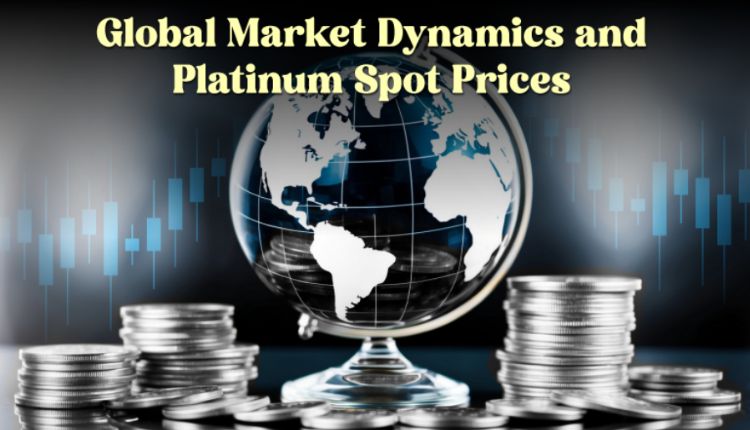Live platinum spot prices are fluctuating quite a bit in the current market dynamics. The spot price for platinum is $934. as of 3rd Sep 2024. It is expected that the overall market demand for platinum is going to increase by USD 1. 75 billion by 2025, with a Compound Annual Growth Rate (CAGR) of 4%. 36% from 2024 to 2028. This is due to the rising demand in sectors such as automotive, electronic, and chemical industries and other related sectors. The spot price of platinum remains a key determinant for many different market factors ranging from investment to manufacturing uses.
The increasing trend of platinum jewelry and the utilization of platinum in medical technologies are also contributing to the market demand. Therefore, knowing more about the market, particularly the platinum spot prices, is critical for investing in this valuable but volatile area.
Supply and Demand Dynamics
Considering the year 2024, South Africa remains the global leader among platinum-producing countries, with Russia closely trailing behind. Other prominent producers include Zimbabwe, Canada, and the United States, whose production is relatively smaller than that of Mexico.
It is expected that regions of Asia-Pacific will continue to maintain dominance in the forecast period due to rising demand from countries like China, India, and Japan. According to a World Gold Council survey, 53% of the Chinese “Gen-Z” consumers favored diamond and platinum jewelry, leading to increased demand for platinum, so platinum prices.
In China, the automotive production is moving gradually towards innovative electric vehicles with an aspiration to achieve 20% production by 2025, expanding the usage of platinum for low friction coatings. It is also fueled by India’s automotive industry and the growing glass industry.
The electronics and IT industries increased by 8% year-on-year in Japan in 2021, which also added to the demand for platinum in the region. This will be added to the 2024 outlook: market deficit of 476,000 koz, near-record low supply, and the highest automotive demand for seven years, while the jewelry demand in India grew by 53% YoY in Q1 2024.
Geopolitical Influences on Platinum Prices
Platinum spot prices have demonstrated a somewhat volatile trend in the last two decades due to variations in economic factors, global events, and changes in demand for precious metals for industrial and investment purposes.
At the beginning of the new millennium, the cost of platinum bullion was at an average of $420 an ounce. It peaked at around $2,200 in February 2008 but dropped close to $1,000 by the end of that year. It stands in the range of $800 to $1,400, with an average of $1000 in the past decade.
The price declined and hit a low of $623.50 in March 2020 during the COVID-19 pandemic but recovered after the event. As of the most recent data, platinum opened at $1,027.75 per ounce, reflecting a 4.57% increase from the previous day and a 4.05% rise since the start of the year. The lowest price within the last day was $986.25 per ounce, while the highest was $1,027.75 per ounce.
Since platinum is an international commodity, changes in the value of the U. S. dollar as the bridging currency often affect platinum spot prices based on the XPT/USD trading pair. Ongoing conflicts in platinum-producing nations such as South Africa and Russia can destabilize the supply, leading to fluctuating prices. Also, the last aspect influencing prices is the sentiment and speculations of the investor. Looking at the value of platinum in other currencies – like XPT/EUR or XPT/GBP – can reveal even more about the nature of its market.
Technological Advances and Platinum Prices
The further evolution of the platinum market depends mainly on the continued technological developments, especially in the energy and healthcare sectors. This type of fuel will require the use of platinum as a catalyst, and the market for hydrogen fuel cells is expected to grow immensely given its importance in cutting carbon emissions, hence more demand for platinum. The newer generation of catalytic products remains a focus, especially in the automotive industry, where platinum achieves higher efficiency in meeting emissions standards.
Also, due to their conductivity and stability, platinum has been found to be an application in high-performance electronics and in new nanotechnologies. In medicine, platinum-based compounds are critical in cancer therapy, and further investigations may broaden their application in medicine.
Fluctuations in platinum production arising from geopolitical events and disruptions affecting major platinum supply countries, including South Africa and Russia, affect the platinum spot prices. Additionally, the promulgation of platinum recycling from catalytic converters and industrial catalysts presents another means of accessing platinum in a non-mining manner and could have implications on the availability and cost of the metal.
With the ongoing transition towards cleaner sources of energy and improvements in the recycling capacity of resources, platinum is well-placed for investors and industries. Their scarcity, coupled with the properties exhibited by the metal, makes it indispensable for various uses, thus guaranteeing its market value.
Global Economic Events Affecting Platinum Prices
Macroeconomic policy is the most influential determinant of investment and financial dynamics, and precious metals, including platinum, are sensitive to changes in Global Economic Policy Uncertainty (GEPU). Such uncertainties can result in fluctuations in platinum spot prices within the market, particularly in the context of economic instabilities.
As the data demonstrates, the price of platinum significantly follows the volatility of global economic policy. Since economic policies are often changed to manage economies and promote financial growth, such fluctuation has a large impact on decision-making processes. This impact is quite discernable from analyses involving precious metals, such as platinum, regarding certain time frames, including pre-CoV-ID and during CoV-ID.
In the past, platinum spot prices have been characterized by relatively high fluctuations. Historically, platinum has been trading between $800 and $1,400 per ounce in the past decade, and with the current trends, it is priced lower at $623. 50 in March 2020, mainly due to the impact of the COVID-19 pandemic. Currently, platinum is hovering at a price of about $ 1027. 75 per ounce, which has recently surged but is still lower than the record high it attained.
The prices of platinum are affected by geopolitical events and the world’s economic situation. Finally, the political instabilities of major producers like South Africa and Russia pose a threat to the availability of platinum spot prices.
Future Trends in the Platinum Market
BR Metals, one of the largest precious metal recyclers in Asia, predicts the deficit of platinum will persist through the year 2024, while the global demand is projected to reach 7. 5 million ounces next year. Potentially, the price could reach $800-$1,100 per ounce. Even though it is difficult to pinpoint an accurate price figure for yr 2030 owing to a number of unknown factors, the WPIC believes that fundamental market conditions for platinum will remain positive, with the market registering back-to-back years of shortfalls.
WPIC has forecasted a scarcity of between 500,000 to 612,000 ounces within the period of 2025 to 2027. There is a risk if weak prices persist because, presently, about 25% of the mined primary PGM supply has negative margins due to the 2023 price collapse. Nevertheless, the demand for platinum is expected to remain high, especially in ICE vehicles, with further support from the hydrogen economy.
According to Traderindo’s Laksono, the platinum spot prices might stabilize at $1,250 an ounce for the next seven years, with a long-term potential higher than $1,000. Besides, he underlines the hydrogen economy and FCEVs as a new and emerging market for platinum. The WPIC has highlighted that FCEVs will consume 75% of the estimated demand for platinum in the hydrogen sector in the future. Hynes and Kumari of ANZ Research hold this view, pointing out that although the demand for platinum in hydrogen today remains low, it is expected to increase and counterbalance the back of ICE vehicles.
Conclusion
As the market for platinum progresses, it becomes even more attractive for investors. As supply constraints are expected to continue and demand fueled by innovative uses in clean energy and industry, platinum is poised to stay highly valued. Its demand is also boosted by the projected range of platinum spot prices for the year 2024 and other projections in the subsequent years.
Investing in platinum bullion comes with various benefits, including its status as a tangible asset and a hedge against inflation and economic uncertainty. Anyone who wishes to purchase platinum Coins can visit BOLD Precious Metals, an online store that has a reputation for offering quality bullion and investment products.






